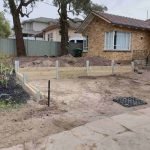Introduction
Retaining walls are more than simply practical structures; they are an essential part of landscaping and engineering that can boost the aesthetic appeal of any residential or commercial property. As urbanization continues to increase, so does the need for ingenious style and installation methods. With a myriad of options readily available-- from timber sleepers to concrete sleepers, and even advanced materials like H beams-- the landscape of retaining wall design is ever-evolving. This post aims to check out The Most current Trends in Retaining Wall Style and Installation, shedding light on contemporary strategies, materials, and expert recommendations.
The Newest Patterns in Retaining Wall Style and Installation
As we dig deeper, it's crucial to understand what makes up the most recent trends in retaining wall style and setup. Over the last few years, there has been a noticeable shift towards sustainability, looks, and performance. Property owners are now more concerned about how their maintaining walls suit the general landscape design while likewise focusing on durability.
1. Sustainability in Materials
1.1 Environmentally friendly Options
Sustainable products like recycled concrete or sustainably sourced lumber are getting traction. These materials not just minimize environmental effect but likewise supply distinct visual qualities.

1.2 Permeable Designs
Permeable maintaining walls enable water drain, avoiding soil erosion while promoting natural groundwater recharge. This pattern aligns with eco-conscious landscaping practices.
2. Ingenious Engineering Techniques
2.1 Modular Blocks
Modular blocks have ended up being progressively popular due to their ease of installation and versatility. These blocks can be designed to simulate natural stone or other products, supplying visual versatility without compromising strength.
2.2 Strengthened Structures
Incorporating enhanced steel bars or mesh within concrete walls adds stability, allowing for taller installations without jeopardizing safety.
3. Visual Trends in Maintaining Walls
3.1 Natural Stone Facades
The usage of natural stone facades creates an ageless appearance that blends perfectly with the environment. This trend attract homeowners looking for elegance integrated with durability.
3.2 Vertical Gardens
Integrating greenery into retaining walls through vertical gardens is another amazing pattern that enhances visual appeal while enhancing air quality.
4. Smart Innovation Integration
4.1 Automated Watering Systems
Smart watering systems incorporated into retaining walls make sure optimal wetness levels for any plants included into the structure, thereby enhancing plant health.
4.2 Monitoring Systems
Advanced sensing units can monitor soil pressure and moisture levels, informing property owners when maintenance is required.
5. Diverse Product Use: Lumber vs Concrete vs H Beam
5.1 Timber Sleepers: Pros and Cons
Timber sleepers use a natural aesthetic however need routine upkeep due to vulnerability to rot and bug damage.
Pros:
- Aesthetically pleasing Easy to install
Cons:
- Requires maintenance Less resilient than concrete
5.2 Concrete Sleepers: Resilience Satisfies Versatility
Concrete sleepers have actually become a go-to choice due to their long life expectancy and https://tuffstuffretainingwalls.com.au/ low upkeep requirements.
Pros:
- Highly durable Fire-resistant
Cons:
- Heavier than timber Limited aesthetic variation
5.3 H Beams: The Structural Marvels
H beams supply extraordinary strength for massive tasks where standard approaches may not be sufficient, making them a perfect option for industrial applications.
Professional Setup: Why It Matters?
When it concerns setting up keeping walls, employing specialists can make all the difference between success and disaster.
6. Proficiency Matters in Retaining Wall Projects
Professionals bring experience that guarantees security requirements are satisfied while attaining the wanted look and functionality of your wall.
7. Cost Efficiency Through Professionalism
While DIY might appear cost-effective at first, professional installation frequently leads to fewer errors-- conserving money in repair work down the line.
FAQs About Retaining Wall Design
Q1: What is the best material for a retaining wall?
A1: The very best material depends upon your specific needs-- timber is great for aesthetics; concrete offers sturdiness; H beams supply structural stability for larger projects.
Q2: How high can a residential retaining wall be?
A2: Generally, residential keeping walls must not surpass 4 feet without professional engineering suggestions due to safety concerns related to soil pressure.
Q3: Do I require a license for constructing a maintaining wall?
A3: Yes, many towns require authorizations for keeping walls above a particular height-- check local policies before continuing with construction.
Q4: How do I keep my timber sleeper wall?
A4: Routine assessments for signs of rot or insect damage are essential; applying sealants can extend its life-span significantly.
Q5: Can I build my own maintaining wall?
A5: While do it yourself is possible for smaller sized walls utilizing lighter materials like wood sleepers, it's suggested to seek advice from specialists for bigger setups or complex designs.
Q6: Exist alternatives to conventional retaining walls?
A6: Yes! Alternatives consist of terracing or using natural boulders which can be both functional and aesthetically pleasing while decreasing erosion danger effectively.
Conclusion
In conclusion, comprehending The Most current Patterns in Retaining Wall Design and Installation allows homeowners and builders alike to make informed decisions tailored to their unique needs-- stabilizing aesthetics with functionality while considering sustainability concepts in addition to innovative innovation combination into landscape architecture today! Whether you opt for lumber sleepers, concrete sleepers, or innovative H beams-- the options are abundant! So take your time investigating each option thoroughly before diving into your next project!
Incorporating these modern-day trends not only raises your property's curb appeal but also boosts its worth significantly!